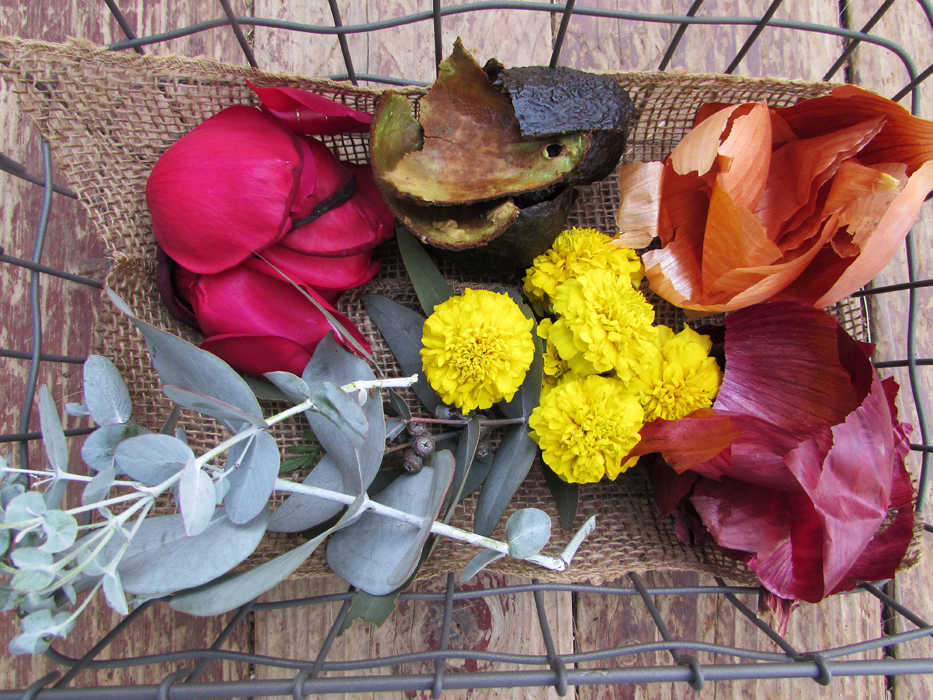Homegrown botanical dyes are in, part of today’s shift toward more natural and organic living.
And you don’t need a degree in chemistry to create your own hues for scarves, sweaters or even Easter eggs.
All it takes is a garden plot or a few pots and a kitchen.
“If you’re already gardening or already even have a landscape, you can look out your window and you can use the things that are there, that you’re already growing, for a dyer’s garden,” says Chris McLaughlin, a gardener in Placerville, California, and author of the new book “A Garden to Dye For: How to Use Plants from the Garden to Create Natural Colors for Fabrics and Fibers” (St. Lynn’s Press).
If you’re planting a new dye garden, McLaughlin’s book contains several different garden plans. An edible dye garden, for example, might be best if you have limited space and can’t justify giving up square footage for anything other than fruits and veggies. Suggested plants include carrots, bee balm, rosemary, purple basil, red onions, chamomile, beets, blueberries, red cabbage and marjoram.
A cutting dye garden features flowers that can be cut for indoor display or tossed in the dye pot. McLaughlin recommends roses, hollyhocks, dahlias, rudbeckia, purple coneflowers, zinnias and cosmos.
Of course, you can always mix veggies and flowers, or plant a few items in containers.
And if you’re already gardening, chances are you have some of these plants and flowers in your backyard.
“Even a typical suburban landscape that was planted by the housing developer might have birch, juniper, roses, Japanese maple or eucalyptus,” McLaughlin says.
For beginners, French marigolds and onions (red or yellow) are easy to grow and produce vivid colors for dyes, according to Julie Jensen, farmer and founder of Echoview Farm and Fiber Mill near Asheville, North Carolina.
Appearance isn’t everything. The vibrant pink flowers of the peony, for example, result in a pale lime green when used for dye, according to Howard Freilich, founder of the New York-based landscaping service Blondie’s Treehouse.
Here’s a list of his favorite sources for various hues:
Beets (roots) – deep red
Rose (hips) – red
Lilac (twigs) – yellow/orange
Golden Rod (flowers) – yellow
Coneflower (flowers) – brownish green; (leaves and stems) – gold
Ivy (twigs) – yellow/brown
Onion (skin) – orange
Carrot (roots) – orange
Foxglove (flowers) – apple green
Peppermint (leaves) – dark khaki green
Peony (flowers) – pale lime green
Hyacinth (flowers) – blue
Purple Iris (flowers) – blue
Hibiscus (flowers, dark red or purple) – red-purple
Oregano (dried stalk) – deep brown/black
Iris (roots) – black
A dye garden doesn’t require any more work than a typical garden. But Freilich notes that dye content in plants is significantly influenced by temperature, humidity and sun exposure.
“So you want to make sure that the plant is growing in its ideal condition,” he says.
McLaughlin recommends leaving at least 4 feet of space around the beds to make it easier to harvest and tend to the plants and flowers. That leaves room for wheelbarrows and other equipment.
Blossoms should be in full bloom, and berries and nuts ripe when harvesting plants for dyes, according to Freilich.
As for roots, the dye content increases as the plant ages. However, most of the plants that contain dyes in their roots are perennials, and will take two to three years to develop enough dye for harvesting, he says.
If picking an entire plant or leaves, do so at the end of their growing season so the dye content is at its peak.
Naturally dyed play dough
— 2 cups flour
— 1 cup salt
— 1 tablespoon cream of tartar
— 1 1/2 cups water
— 1/2 cup natural dye (can be created from blueberry, beetroot, onion skins, red cabbage, spinach leaves, cranberries, hibiscus tea, grape juice, turmeric, etc.)
— 1/4 cup oil
Heat all ingredients in a pot on the stove on low to medium heat. Using a wooden spoon, stir continuously until the mixture pulls away from the sides of the pot.
Continue stirring until it really pulls away from the sides, gets deeper in color and becomes a big ball.
Let cool.
To make smaller batches in a variety of colors, divide the dough into equal parts and punch into the center of each one. Add a different dye to each one, kneading it into the dough.

